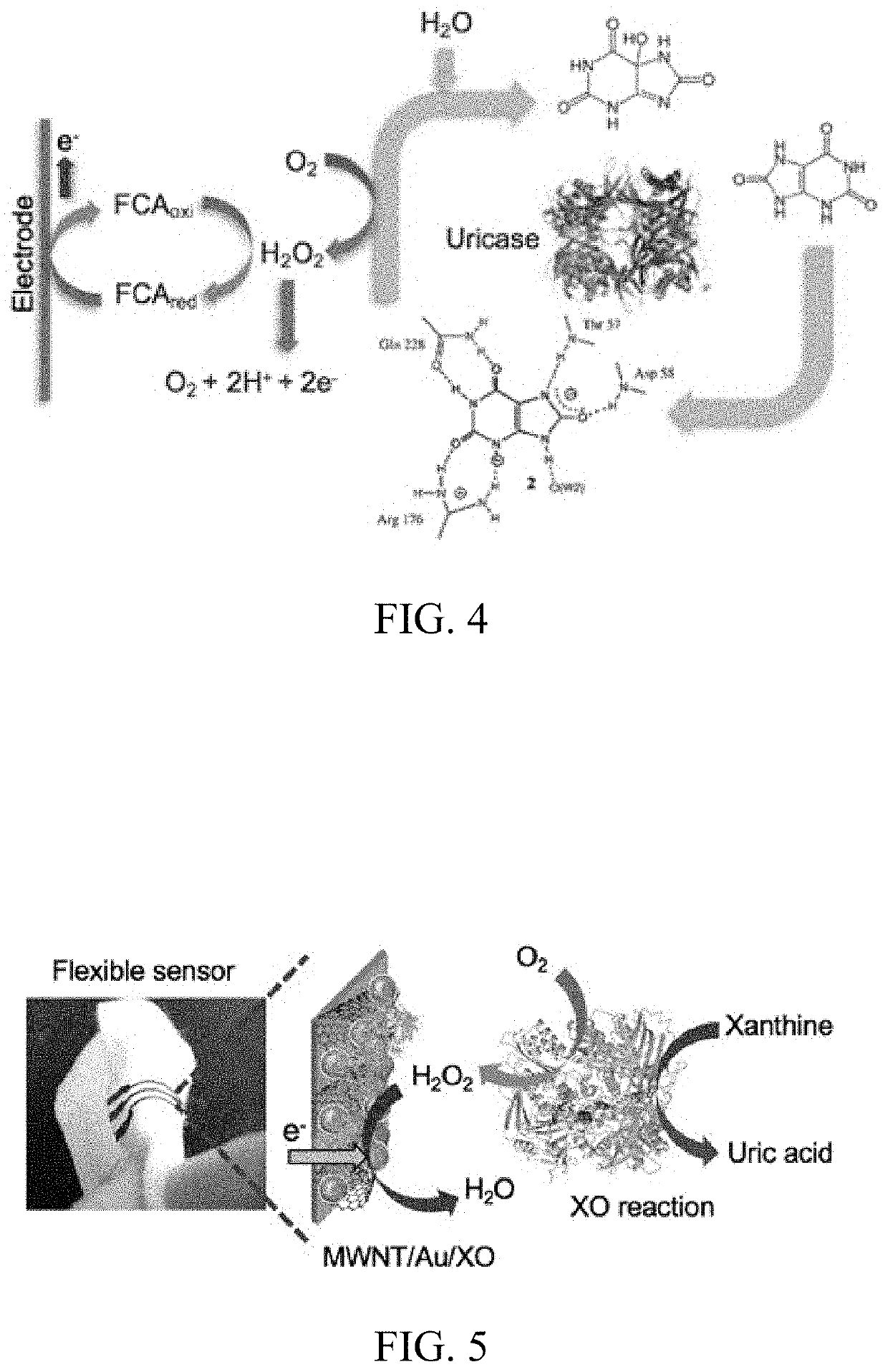Wound monitoring sensors and use thereof
a technology for monitoring sensors and wounds, applied in the field of wound monitoring sensors, can solve the problems of traumatic amputation, systemic infection, and increased risk of chronic wounds, and achieve the effects of reducing the capability of continuous monitoring, facilitating stable and selective detection of biomarkers, and reducing the occlusion of biosensors
- Summary
- Abstract
- Description
- Claims
- Application Information
AI Technical Summary
Benefits of technology
Problems solved by technology
Method used
Image
Examples
example 1
cterization of Metal Nanostructures
[0146]Platinum, silver and gold nano-material were explored for detection of byproduct, hydrogen peroxide, and UA on the nano-structure modified SPCE and were characterized using SEM (FIG. 6).
[0147]FIG. 6a represents the SEM image of Pt nano-flakes obtained from electro-deposition over a growth period of 15 min at 35° C. This growth period of the flake like structures was optimized over different time periods (15-45 min) and temperatures (35° C.-75° C.). As given in the same SEM images, the Pt nano-flakes have the morphology of thin sheets arranged vertically with numerous edge planes. At 35° C. over 15 min electro-deposition period, the Pt nanoparticles show distinct, regular growth of nano-flakes, with a thickness of platelets in the range of 25 nm to 30 nm with a length of ˜252 nm, at this stage of formation (FIG. 6b). The regularity conformation of these Pt nano-flakes was controlled over different deposition growth periods. SEM characterizatio...
example 2
Enzyme Characterization
[0149]The enzyme UOx was entrapped in PVA-SbQ, a cationic polymer for immobilization on the electrode. The amine group of the styrylpyridinium side chains in the PVA backbone offers firm electrostatic attachment to immobilize the enzyme on the electrode surface. This is due to the net charge of the enzyme being partially negative (6-) above pH 7.5. The pKa and the isoelectric point values of UOx are 4.64 and 7.5, respectively. This binding and interaction of the amino acid chains of UOx with the polymer is depicted in FIGS. 7a and b. The polymer structure in the schematic has minimized bond energy.
[0150]The UOx entrapped in PVA cationic polymer was characterized by various spectroscopic, optical and electrochemical techniques to assess the surface morphology and characteristic behavior. The physisorbed UOx on the electrode surface was used as a control in all these studies. To obtain highest loading of UOx on the electrode surface, various ratios of polymer an...
example 3
Natural Catalyst for UA Detection
[0158]UOx is an enzyme that belongs to the catabolism of the purine degradation pathway. It plays an integral role in the enzymatic conversion of uric acid (C5H4N4O3) to 5-hydroxyisourate (C5H4N4O4) through oxidation (Eq. 1). The formed 5-hydroxyisourate reacts with water to produce carbon dioxide and allantoin (C4H6N4O3) (soluble form of urate) (Eq. 2). The oxidation of urate to racemic allantoin occurs through the formation of unstable intermediates. In this reaction, C-5 of urate is converted to C-4 of allantoin, while C-2 of urate was recovered as C-2 of allantoin. Yield of the byproduct (H2O2) from this reaction was utilized in well-established colorimetric assay techniques to quantify UA.
UA+O2+H2O→5-hydroxyisourate+H2O2→ (1)
5-hydroxyisourate+H2O→allantoin+CO2→ (2)
[0159]The domain structure of UOx is 50 Å long with a 12 Å wide tunneling fold (T-fold), and is formed from the union of dimers stacked via hydrogen bonds. It is a globular homotetra...
PUM
 Login to View More
Login to View More Abstract
Description
Claims
Application Information
 Login to View More
Login to View More - R&D
- Intellectual Property
- Life Sciences
- Materials
- Tech Scout
- Unparalleled Data Quality
- Higher Quality Content
- 60% Fewer Hallucinations
Browse by: Latest US Patents, China's latest patents, Technical Efficacy Thesaurus, Application Domain, Technology Topic, Popular Technical Reports.
© 2025 PatSnap. All rights reserved.Legal|Privacy policy|Modern Slavery Act Transparency Statement|Sitemap|About US| Contact US: help@patsnap.com



